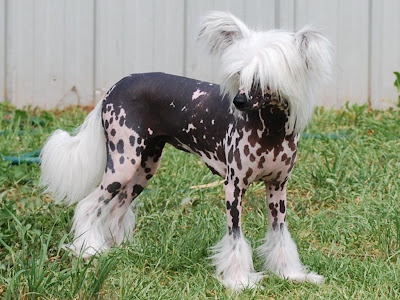The Chinese Crested Dog Is devoid of hair except for the crown of the head, lower part of the limbs and tail. The breed is produced by a dominant gene for hypotrlchosls (Hr) In combination with the gene for long hair (/). The homozygote (Hr) Is a prenatal lethal, hence the Chinese crested dog Is an obligate heterozygote. The long haired segregants, ++II, are known as powderpuffs. HAIRLESS DOGS arc of considerable antiquity, being described as early as 1600 and subsequently by several distinguished zoologists. Their accounts indicate that the hairless dog >. has been reported from many subtropical regions of the world where the lack of an insulating pelage is not a disadvantage. Their unique appearance invariably excites interest and they have been given such exotic names as the African, Ceylon, Chinese, Egyptian, and Turkish hairless dog1"3. It is doubtful if many of these merit designation as breeds although the Mexican hairless and the Xoloitzcuintli are often referred to in these terms.
The Chinese crested dog has been since the latter part of the 19th century10, but it is only comparatively recently that it has gained significant popularity among breeders in the United States and Britain. The dog is basically similar to the other hairless dogs but differs in the greater amount of hair shown on the extremities, viz., crown of the head, feet, and tail. Previous accounts of breeding hairless dogs have indicated that the hairlessness is due to a dominant gene that is lethal when homozyigous. Consequently, normal coated offspring are to be expected to occur in breeding the Chinese crested if the hairlessness is due to a similar gene. This is the situation and the normal coated dogs are known as powderpuffs.
The growing popularity of the Chinese crested Dog has meant that reasonable numbers are being bred instead of the odd few litters had the dog remained a rarity. An appeal was made by' personal contact, postal communications, and via the medium of the canine press for breeders to furnish information on their breeding. Details were requested for the parents and for each pup in the litter. Information was obtained for 83 litters comprising 330 pups. These were divided into 30 litters of 143 pups for matings of Chinese crested to powderpuff, and 53 litters of 187 pups from Chinese crested to Chinese crested. The distribution of litters was roughly normal but slightly skewed toward smaller litters for both matings. For the first, the range was from two to eight pups per litter, a mode at five pups and a mean of 4.77 ± 0.30 pups. For the second, the range was from one to seven pups, a mode at four pups and a mean of 3.52 ± 0.21 pups. The difference between means of 1.24 ± 0.34 is highly significant.
The progeny from both matings consisted of both Chinese crested and powderpuff pups. From matings between Chinese crested and powderpuff, there were 79 Chinese crested and 64 powderpuff. The deviation from a monogenic 1:1 ratio is nonsignificant (x2 = 1.57 for 1 df). From matings between Chinese cresteds, there were 129 Chinese crested and 58 powderpuffs. The deviation from a monogenic 3:1 ratio is subsignificant (x2 = 3.61 for 1 df). However, the data are a better fit to a 2:1 ratio upon the assumption that the homozygous hairless is lethal (x2 = 0.46 for 1 df).

















0 comments:
Post a Comment